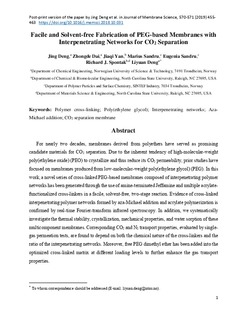| dc.contributor.author | Deng, Jing | |
| dc.contributor.author | Dai, Zhongde | |
| dc.contributor.author | Yan, Jiaqi | |
| dc.contributor.author | Sandru, Marius | |
| dc.contributor.author | Sandru, Eugenia | |
| dc.contributor.author | Spontak, Richard J | |
| dc.contributor.author | Deng, Liyuan | |
| dc.date.accessioned | 2019-04-02T06:41:54Z | |
| dc.date.available | 2019-04-02T06:41:54Z | |
| dc.date.created | 2018-10-22T23:07:01Z | |
| dc.date.issued | 2018 | |
| dc.identifier.citation | Journal of Membrane Science. 2018, 570-571 455-463. | nb_NO |
| dc.identifier.issn | 0376-7388 | |
| dc.identifier.uri | http://hdl.handle.net/11250/2592798 | |
| dc.description.abstract | For nearly two decades, membranes derived from polyethers have served as promising candidate materials for CO2 separation. Due to the inherent tendency of high-molecular-weight poly(ethylene oxide) (PEO) to crystallize and thus reduce its CO2 permeability, prior studies have focused on membranes produced from low-molecular-weight poly(ethylene glycol) (PEG). In this work, a novel series of cross-linked PEG-based membranes composed of interpenetrating polymer networks has been generated through the use of amine-terminated Jeffamine and multiple acrylate-functionalized cross-linkers in a facile, solvent-free, two-stage reaction. Evidence of cross-linked interpenetrating polymer networks formed by aza-Michael addition and acrylate polymerization is confirmed by real-time fourier-transform infrared spectroscopy. In addition, we systematically investigate the thermal stability, mechanical properties and water sorption of these multicomponent membranes. Corresponding CO2 and N2 transport properties, evaluated by single-gas permeation tests, are found to depend on both the chemical nature of the cross-linkers and the ratio of the interpenetrating networks. Moreover, free PEG dimethyl ether has been added into the optimized cross-linked matrix at different loading levels to further enhance gas-transport properties. | nb_NO |
| dc.language.iso | eng | nb_NO |
| dc.publisher | Elsevier | nb_NO |
| dc.rights | Attribution-NonCommercial-NoDerivatives 4.0 Internasjonal | * |
| dc.rights.uri | http://creativecommons.org/licenses/by-nc-nd/4.0/deed.no | * |
| dc.title | Facile and Solvent-free Fabrication of PEG-based Membranes with Interpenetrating Networks for CO2 Separation | nb_NO |
| dc.type | Journal article | nb_NO |
| dc.type | Peer reviewed | nb_NO |
| dc.description.version | acceptedVersion | nb_NO |
| dc.source.pagenumber | 455-463 | nb_NO |
| dc.source.volume | 570-571 | nb_NO |
| dc.source.journal | Journal of Membrane Science | nb_NO |
| dc.identifier.doi | 10.1016/j.memsci.2018.10.031 | |
| dc.identifier.cristin | 1622444 | |
| dc.relation.project | Norges forskningsråd: 254791 | nb_NO |
| dc.description.localcode | © 2018. This is the authors’ accepted and refereed manuscript to the article. Locked until 16.10.2020 due to copyright restrictions. This manuscript version is made available under the CC-BY-NC-ND 4.0 license http://creativecommons.org/licenses/by-nc-nd/4.0/ | nb_NO |
| cristin.unitcode | 194,66,30,0 | |
| cristin.unitname | Institutt for kjemisk prosessteknologi | |
| cristin.ispublished | true | |
| cristin.fulltext | preprint | |
| cristin.qualitycode | 2 | |

